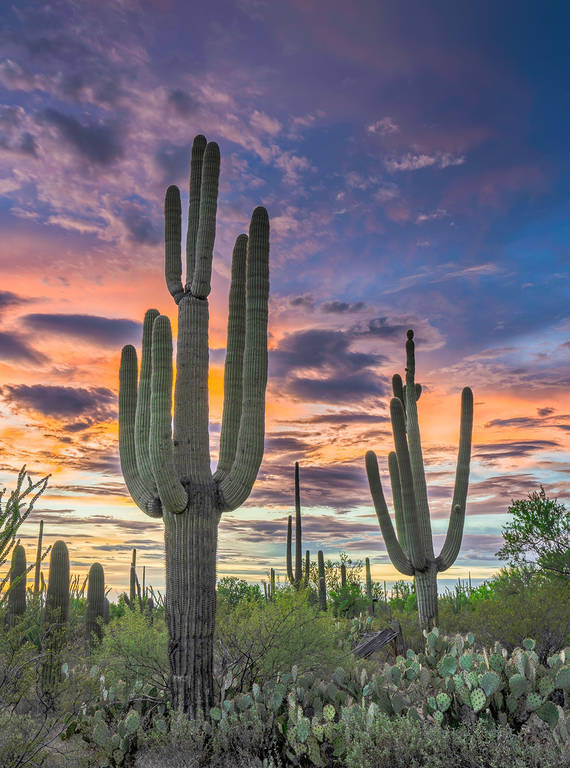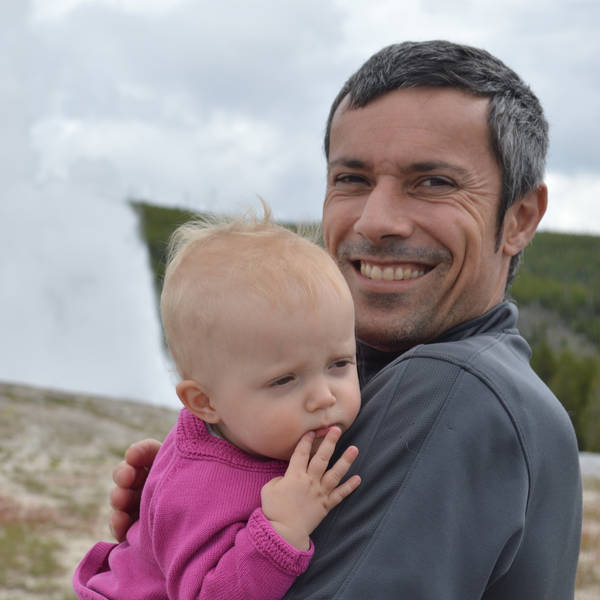Winter 2023
A Thorny Question
Why some saguaros grow more arms than others — and why it matters.
Every spring break, Richard Hutto would drive to the Southwest with a group of his field ecology students to conduct some basic science. The first day, they’d walk around the desert looking for interesting patterns. Then they’d gather at a campground at night and brainstorm their ideas, and each student would settle on a particular line of inquiry. Hutto, then a professor at the University of Montana, would pick his own scientific quest, “because you’ve got to be doing something all day,” he said.
And so it was that in March 2000 at Organ Pipe Cactus National Monument in southern Arizona, Hutto set his sights on the Sonoran Desert’s stately icon — the saguaro cactus. Several years earlier, Hutto had examined the distribution of saguaro seeds and discovered they’re more abundant near trees such as mesquite or palo verde. This time, he contemplated the cactus’ varying shapes. “One of the immediate things that catches your eye is why do some saguaros have lots of arms and why others have none,” he said. It would take two decades and the free time afforded by retirement for Hutto to finally publish his answer.

Water has long been suspected of influencing the number of arms each saguaro grows.
©ANDREAS STROH/SHUTTERSTOCKSaguaros (pronounced sah-wah-rohs), whose range extends across southern Arizona, northern Mexico and a small chunk of southeastern California, have long been the object of fascination — and deservedly so: They’re not only among the tallest cacti in the world (more on that later) but also among the oldest, with some living up to 300 years. But the matter of the saguaro’s so-called branching pattern is one that has piqued the interest of Hutto and many other scientists, and it’s a question with both ecological and cultural ramifications.
The arms that give saguaros their iconic shape are actually crucial to the species’ survival. Saguaros produce flowers almost exclusively on their extremities, so on a pillar-shaped saguaro, flowers will appear at the top. Once that saguaro grows one arm, the number of flowers — and seeds — will roughly double. Add one more arm, and the number of flowers will be about triple what it was originally, and so on. “We like for them to have as many arms as they can get away with,” said Don Swann, a biologist at Saguaro National Park and the co-author of several research papers on the park’s namesake.
The cacti’s flowers eventually turn into fruits, and those hold deep significance for the Tohono O’odham, whose name translates as desert people. From the end of June to the beginning of July, they harvest the fruits using long tools built out of dead saguaro ribs, said Austin Nuñez, chairman of the San Xavier District of the Tohono O’odham Nation. The fruits are used to make a jam and a very light wine that is central to the Tohono O’odham’s rain ceremony. “The songs that are sung during the ceremony are to call for the rain and for good crops,” Nuñez said. “And usually, like four days later, it would rain, and so that was the beginning of our new cycle year.”
Saguaros grow extremely slowly. After five years, most haven’t reached an inch in height. “It’s so fun to find a baby saguaro no bigger than your baby finger,” Hutto said. It takes decades for a saguaro to produce fruit and years more to grow its first arm — if it produces one at all — so observing growth patterns in real time is not a practical option. The best approach, then, is statistical.
KILLER WEED
To figure out which factors might play a role in determining a saguaro’s number of arms, Hutto walked 1-kilometer transects in various areas of Organ Pipe, stopping at regular intervals to record the height of the saguaros he came across (which correlates to their age), the number of arms (those long enough to begin to turn), the species of nearby trees, the number of surrounding saguaros, and the existence or absence of a wash in the vicinity. In total, he surveyed 425 saguaros, and the highest number of arms he recorded was a modest 12. Saguaro National Park’s Granddaddy, once thought to be the world’s oldest saguaro, sported 52 arms before succumbing in the mid-1990s. A saguaro called Shiva for its very large number of arms (78) grows north of Tucson.
The first relationship Hutto examined is the one between branching and height, and he confirmed that the correlation was not straightforward. “There’s a huge amount of slop around that line,” he said. (The world’s tallest cactus, which was felled by a windstorm in 1986, was a 78-foot-tall saguaro in Cave Creek, Arizona, that was estimated to be 150 years old. It was also armless.)
Water plays a major role in the growth of saguaros and has long been suspected to influence the number of arms. Predictably, Hutto found that the existence of a wash tended to be associated with more arms, while the presence of nearby saguaros that compete for water seemed to result in fewer arms. Interestingly, nurse trees appeared to influence saguaro branching when they were alive — and dead. Nurse trees are associated with a relative abundance of young saguaros — perhaps because of the shelter they provide to the seedlings or because birds perched on their branches excrete saguaros seeds that germinate under the canopy. Hutto discovered that saguaros growing near living nurse trees tended to have fewer arms, possibly because both species competed over water, but a saguaro next to a dead nurse tree was more likely to grow more arms. “Why that is, I don’t know,” he said. In all, the main factors examined by Hutto in his 2021 study accounted only for 15% of the variation in the number of arms.
So what else could be at play? Taly D. Drezner, a physical geographer at the College of Southern Nevada, assembled her own massive dataset on saguaros and published more than 35 papers on the cactus, including half a dozen on branching. In one of those, she compared her saguaro data with climate information for the cactus’ range, and she found that, contrary to what many experts thought, summer monsoons were not the best predictor of branching patterns. “The areas with a lot of branches are clearly the areas where they get a lot of winter rain,” she said. Drezner, who found a few years ago that the 1883 eruption of Krakatoa in Indonesia affected the global climate in a way that benefited young saguaros in Arizona, knows that there are a lot of saguaro-related mysteries left to be solved.

National Parks
You can read this and other stories about history, nature, culture, art, conservation, travel, science and more in National Parks magazine. Your tax-deductible membership donation of $25 or more entitles…
See more ›Nuñez isn’t sure why saguaros have more or fewer arms, but he’s certain the cacti have human qualities. He recounted a story told by one of his fellow Tribal members to anthropologists in which a woman’s grandson transforms into a saguaro. Recognizing his voice, the grandmother embraces him and dies from her injuries, but the boy-turned-saguaro endures and promises to bear fruit for his people. In the aftermath of the destruction of saguaros during the construction of the U.S.-Mexico border wall, Nuñez authored a resolution — adopted by his nation’s government — that acknowledged the plant’s “personhood.”
“We hold them in high regard and believe that they are relatives,” Nuñez said. “I just took it for granted that they have arms.”
About the author
-
 Nicolas Brulliard Senior Editor
Nicolas Brulliard Senior EditorNicolas is a journalist and former geologist who joined NPCA in November 2015. He serves as senior editor of National Parks magazine.



